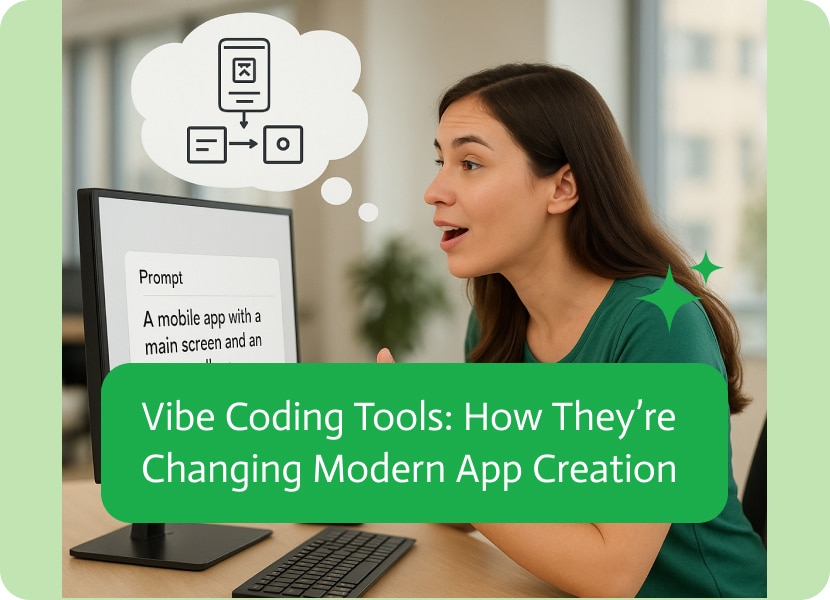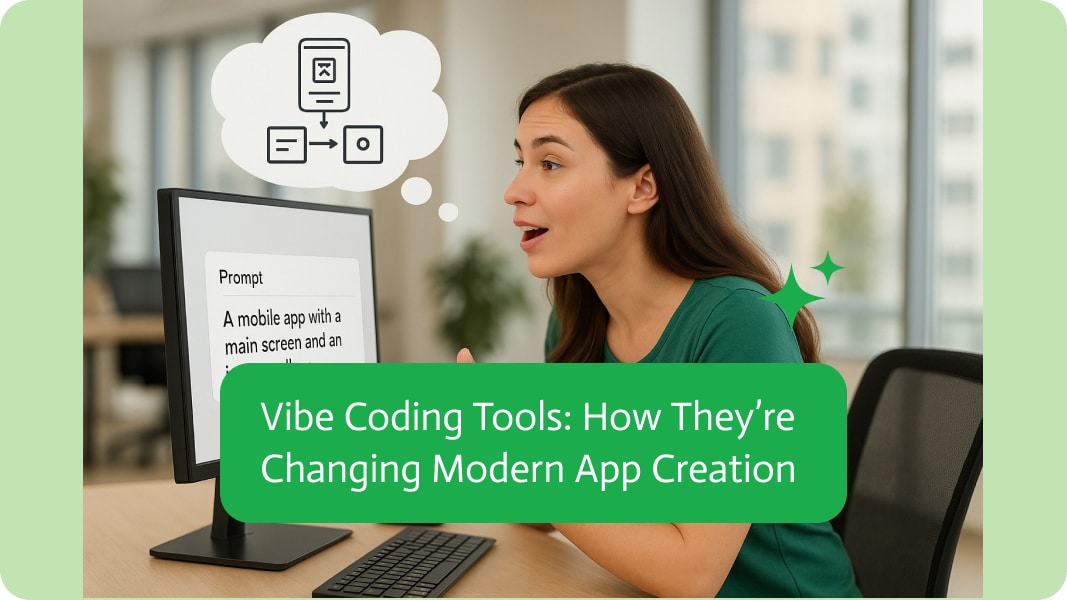

Vibe Coding Tools: How They’re Changing Modern App Creation
If you’ve ever tried designing an application, you’ve obviously aware of how it can feel like putting together ready-to-assemble furniture without instructions, but the screws are in a weird coding language. That’s exactly where these vibe coding tools come in. They’re new platforms and helpers that are changing how apps are made. Now, it’s not just for developers but also for newbies that can use this creativity tool to create just about anything digital. They are changing who can code, how fast we can build, and what we can even do.
What Exactly Is “Vibe Coding”?
Vibe coding isn’t just another digital craze where people code while listening to music. It’s a way of thinking and a set of tools that blends creative design with AI and merges the roles of developers and designers. When you use vibe coding tools, you start with the outcome you want — the behavior, the look, and the overall feeling and the system turns that into fully functional software.
Imagine saying, “I want a web application via prompt that lets users log in with Google, view a dashboard with recent tasks, and get alerts for new messages,” and watching your app scaffold itself in minutes. That’s the essence of vibe coding.
Why Traditional Coding Just Isn’t Cutting It Anymore
Traditional software development isn’t broken, it’s just not built for speed, scale, or spontaneity. Here’s the modern reality:
- Launch timelines are shrinking.
- Teams are more cross-functional.
- Users expect polished, real-time features, like yesterday.
- Innovation waits for no sprint cycle.
The conventional dev stack, write specs, hand off to devs, test, iterate, but it’s too slow and brittle. It’s built for stability, not agility. That’s fine when you’re building a banking backend. But what if you’re prototyping a new social app, internal dashboard, or custom AI automation workflow? You need to move fast, break fewer things, and vibe your way to value.
How Does Everything Actually Happen Behind The Scenes
Vibe coding blends state-of-the-art tech to smooth out just about every single bump on your journey, all while still keeping the code sturdy enough for real-world apps. Picture a digital studio where ideas can wander and AI quietly fills in the gaps.
Natural Language Interfaces
Long specs and messy wireframes feel like ancient history now. With vibe coding, you speak to your setup the same way you would a coworker: Make your login page with Google and email sign-in, and then send users to a dashboard after authentication.
The engine doesn’t just take a wild guess, it actually reads your intent. Whether you’re a code pro or a designer tossing out rough thoughts, the interface turns those half-formed ideas into working snippets.
And you never get locked in. Want a dark-mode toggle or a new flow? Just type the change. The system picks it up, learns from your style, and makes the necessary updates instantly.
AI-Assisted Code Generation
Behind the user-friendly screen sits some heavy-duty tech. Large language models-such as OpenAI’s Codex or other custom engines, scan your prompt and spit out real code in whatever stack you like, from React or even TypeScript to Swift and Django.
What you get is more than cut-and-paste boilerplate. The engines spot code patterns. Ask, “Build a form that checks email and phone, then saves to Firestore,” and it returns working JavaScript with validation logic, error catches, and UI hooks already wired.
Because the process is driven almost entirely by artificial intelligence, the tool picks up context the more you use it. This means, more coding and the better it gets at guessing what fits your style. It feels like a top-tier dev sitting right next to you, whispering clean, ready-to-run snippets without crowding your Slack channel.
Low-Code/No-Code Interfaces
With the core engine humming, low-code and no-code tools hand you a fun playground. Drag, drop, resize, and tweak; you can slide layouts, tweak logic paths, hook APIs, put in a few animations all on screen, without losing sleep that you’ll break the whole app.
Traditional no-code platforms often lock you into boring layouts, but the Vibe coding tool gives you freedom wrapped in friendly rules. You can drop in a few lines of code whenever you want, yet the everyday work still keeps you flowing.
Seamless Integrations Galore
No one wants an app that talks to itself only. These vibe platforms ship integration in their core DNA. Stripe shows up at checkout, Firebase handles login, Airtable holds your data, and one of the various LLM’s sprinkle in smarts-yet adding each service feels like snapping Lego.
The best news? You shouldn’t spend all night hunting API docs. Most tools offer AI-guided helpers, ready-made blocks, and point-and-click maps, connecting wires without frying your brain.
Because in the real world, apps live in super crowded virtual cities. They need to chat, share information so they can grow together, or users simply walk away.
Instant Previews & One-Click Deployments
As soon as you write your first code, instead of staring at a loading screen, the app shows a live preview right beside your editor. Swap a color, move a button, or tweak a line of code, and you see the change pop up instantly, no build queue, no hassle.
When the prototype is polished and you want friends, testers, or the whole internet to see it, hitting that deploy button should have the whole thing up and running. You skip the headache of hooks, Docker stacks, or fiddling with those servers located who knows where. Whether the finished app goes to web, mobile, or desktop, the platform wraps up the hard parts behind the scenes.
That steady stream of real-time feedback keeps your momentum up and spots mistakes early, which is huge when there are deadlines lurking just around the corner or you’re racing to get a minimum viable product out the door.
The New App Creators: Not Just Developers
This change isn’t just about tech; it’s turning into a widespread cultural movement, because vibe coding puts software creation in everyone’s hands. Designers, founders, even marketers can jump in and help build. The die-hard coders might not like it, but this thing is catching on like a fire right now.
Here’s what that looks like in real life:
- A founder builds a functional MVP over a weekend without hiring a dev team.
- A designer takes their Figma layout, adds interactions using normal English prompts, and exports live components.
- A sales team builds a tailored client-facing dashboard without waiting on engineering.
- A dev uses vibe coding tools to prototype complex features faster, then fine-tunes the logic in raw code when needed.
It’s not about doing away with developers completely, but more about removing friction between imagination and execution.
Real-World Magic: Vibe Coding Use Cases
Vibe coding isn’t just a cool concept; it’s powering real projects right now across many fields.
1. Startup MVPs
Why spend months and money building an untested app when you can vibe out a minimum viable product in a single week? Tools like Noca and Replit AI help founders skip the endless hiring cycle and ship fast.
2. Internal Tools
Operations teams are now spinning up CRMs, inventory boards, and workflow automations without adding another ticket to engineering’s backlog.
3. Interactive Websites
Marketing needs landing pages that work, not just look good. With Vibe coding, they are able to design crisp, elegant signup flows, onboarding programs, maybe you just want cost calculators in hours instead of weeks.
4. AI-Driven Apps
Dreaming of embedding GPT, Claude, or DALL-E into your product? Modern tools let you drag-and-drop AI agents together the same way you would build IKEA furniture, and the instructions actually make sense.
Noca.ai: The Vibe Coding Powerhouse
Speaking of drag-and-drop magic, Noca is quickly becoming the go-to powerhouse for vibe coding.
Ok, so there are loads of platforms that stop at no-code dashboards or web pages, Noca pushes far beyond templates. It gives creators speed, built-in smarts, and real creative control so they can build exactly what they imagine.
What Makes Noca Stand Out?
- Prompt-Driven Development.
Noca’s natural-language engine seems almost too good to be true. You write a simple description of what you want exactly, and the system builds the logic, interface, and connections for you. Change your mind midway, say, make a page mobile-first or add a dark-mode switch and it adjusts on the spot.
- Built-In AI Assistants.
Whether you’re loading API keys, cleaning data, or wiring up Stripe, you’ll have the help of Noca’s AI buddies. They work quietly at your side, so it’s like having a second developer who never asks for lunch.
- True Cross-Platform Output.
Build once and watch your app land on iOS, Android, and the web. One codebase means no weird bugs that pop up only on certain devices.
- Integration Playground.
Noca talks to APIs the way most people chat. Need Airtable, Notion, Salesforce, or a custom CRM? Hook them up in minutes.
- Collaboration First.
Noca isn’t just for coders alone, but for everyone from product teams to designers can dive in, change text or settings, and never break the build. Noca isn’t trying to push developers out, it just adds turbo tools so everyone can create apps so much faster, smarter, and with a lot less headaches.
Do You Still Need To Know How To Code?
Fair point. Vibe coding doesn’t ditch real code; it just shifts when and why you write it. Noca still lets you peek under the hood of components, API logic, and even backend queries. After the basic stuff is up, devs can jump in and polish. Need faster load times, a neat animation, or a clever edge-case fix? Have at it. The groundwork is already there.
Speed, Creativity, and Sanity: The Triple Threat
Here’s the secret sauce of vibe coding: it collects three wins that usually fight each other.
- Speed: Turn an idea into a working prototype in hours, not weeks.
- Creativity: Less boilerplate means more testing and less hunting bugs.
- Sanity: Say goodbye to midnight panic over stray semicolons or broken builds.
It’s the closest thing we have to a creative flow in app development, and it’s a guarantee that once you taste it, going back to the endless setup feels pointless.
Noca doesn’t stop at just helping you build apps faster , its AI agent platform takes things a step further. These agents can actively monitor your workflows, suggest optimizations, and even automate repetitive tasks without constant human input. Imagine a sales pipeline tracker that not only updates itself but also alerts your team to high-priority leads, or a customer support dashboard where AI agents triage tickets and highlight trends before anyone notices a problem. With Noca, your apps don’t just run; they think, adapt, and help you work smarter.
Final Thoughts: Coding With Vibes
Vibe coding isn’t a quick trend, it’s becoming one of those tools that are essential in terms of how digital products get built. As gen AI levels up, integrations smooth out, and tools get sharper, the line between builder and user will keep blurring.
Expect to see-
- Apps that change to fit your mood, made the moment you ask.
- Workflows that bend and stretch the way you move.
- AI guides that know what you want before you finish typing.
- Team-ups with machines that feel like jamming in a jazz band, not managing a noisy parade.
The rise of vibe coding tools doesn’t mean the end of software engineering, but rather more of a renaissance, a reimagining of sorts, a creative revolution where more people can build bold ideas and where professionals are provided with the tools to do more in less time, with less pain.


